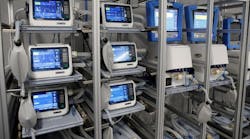“We will not let test be the obstacle in getting ventilators to market.”—Eric Starkloff, President and CEO, National Instruments
It’s no secret that we are experiencing an unprecedented state of emergency. Our healthcare systems are under unimaginable strain from a surge of patients needing testing and treatment. Proper care demands an adequate supply of face masks and ventilators. Meeting that demand is more complicated than simply firing up an assembly line. Effective solutions—such as face masks that can be sanitized and reused—are the result of engineers dedicating countless hours designing, developing, and testing.
It’s our responsibility and privilege to support the global engineering community in their effort to provide the tools necessary to prevent the continued spread of the virus, aid in the treatment of those infected, and take the necessary steps toward finding a cure.
Prevention
In many parts of the world, face masks have sadly gone from a preventative measure to a daily necessity. Even in locations like Korea, where the number of cases has steadily declined, the general population continues to need to use facemasks. An estimated 10 million masks are used and discarded every day in Korea. This not only contributes to continued mask scarcity, it poses a serious environmental concern.
While the shortage has forced many healthcare workers fighting COVID-19 on the front lines to stretch the use of this crucial piece of personal protection equipment (PPE) beyond what is safe, the Korea Advanced Institute of Science and Technology (KAIST) has recently developed a filter that may remedy the issues of conventional masks.
Current face masks, which rely on electrostatics to block particles from passing through, cannot be washed. As the static energy in the filter dissipates, the effectiveness wears off. KAIST, however, has developed a mask filter from interweaved nanoparticles that can be fitted in a cotton mask and is reusable after being washed with soap and water. The material can maintain 94% of its filtration capabilities even after 20 washes and three hours of exposure to alcohol-based disinfectants. This means that the filters can be used with masks for more than a month.
To prepare for commercial use, the filters had to undergo rigorous durability and material tests. This was made possible in a very short period of time using LabVIEW and NI data-acquisition tools.
“As LabVIEW makes it relatively easy for a scientist to build a system, it was possible to build an integrated test setup for easy operation of our equipment by only collecting the functions I want,” said Dr. Won Tae Hwang, Director of Research, KAIST
While these filters still need government clearance before they can be commercialized, they promise to provide a reliable supply while staying environmentally friendly.
Treatment
While the Society of Critical Care Medicine estimates that up to 960,000 COVID-19 patients in the United States may need ventilators for life support, hospitals currently only have around 160,000. Companies such as GE and Ford aim to bridge this gap by standing up manufacturing facilities in Wisconsin and setting goals to accelerate production. These ventilators require thorough testing before use, which can introduce delays in getting equipment to patients in need.
Ventec, developer of the Ventilator, Oxygen Concentrator, Cough Assist, Suction, Nebulizer (VOCSN) five-in-one device, has joined the charge with GM to increase ventilator production. The VOCSN is designed to help reduce the time medical professionals need to manage patient’s ventilator care, making it ideal for the ever-changing crisis we are facing. For companies making ventilators, ensuring efficient testing is an important element in optimizing their output capacity.
While production continues to expand to meet immediate needs, a shrinking global supply chain is delaying or removing key (and difficult to replace) ventilator components, like valves, from the market. Each change in the production process triggers additional tests and FDA approval to ensure that the complex device provides a patient with air in the exact way necessary for medical treatment.
As automotive manufacturers enter the picture, their ability to scale, along with NI tools, allows for testing many more valves in parallel and greatly increase production output. During this pivotal moment, NI’s test and measurement partners, like Velentium, continue to play a crucial role in keeping production moving to ensure the delivery of life-saving equipment designed for situations in which medical professionals and facilities are overwhelmed.
“We started Velentium eight years ago around a passion to change lives for a better world; never has that passion been more directly realized than through some of these projects we are getting to work on today,” said Dan Purvis, CEO, Velentium.
Cure
While stopping the spread of COVID-19 and successfully treating those who are infected are of immediate concern, work is being done to target and halt the replication of the virus altogether. Argonne National Laboratory has developed a 3D image of Nsp15, a protein inside of SARS-CoV-2, the virus causing the COVID-19 outbreak, alongside researchers from University of Chicago, Northwestern University's Feinberg School of Medicine, and University of California Riverside School of Medicine. Nsp15 is 85% identical to a protein found in an earlier version of SARS that has successfully been treated. Previously developed drugs could be used to fight COVID-19.
Argonne has shared this image so that drug companies and other researchers can study it to find out how to stop the virus from replicating. Researchers are using NI solutions to test and calibrate the magnets, which shape the beam that powers the Advanced Photon Source and results in these images being captured for research to fight COVID-19. Thousands of scientists come to the lab each year to use the facility, and the images produced there have led to drugs for AIDS, skin cancer, Type 2 diabetes, leukemia, and more. They also have extensively studied Ebola and Zika virus.
Dave Wilson is Vice President and Business and Technology Fellow of Portfolio Business at National Instruments.
